
Photavit-Werk started its life as Bolta-Werk and produced two camera models with the name Boltavit from 1935. They were tiny miniature cameras, not much larger than a matchbox! In 1937, during production of the second Boltavit, the company name changed to Photavit, so these Boltavits can also be found with the name Photavit. Then followed a series of larger but still subminiature cameras of high specification with a Karat-like film cassette system, the Photavit II to IV. The company also produced several TLR cameras, the Photina range, from 1952-5. Eventually the company also branched out into the 'system camera' market, rangefinder cameras with interchangeable lenses, with the Photavit 36. The company seized production soon after in 1957.
Boltavit I & II
The 1935 Boltavit was a truly miniscule viewfinder camera with collapsible lens mount. Belying its humble size it was fully featured, having adjustable aperture and shutter speeds, a frame counter, adjustable focus and even a cable release socket. The camera used Bolta's proprietary roll film, the Bolta film, which was paper-backed unperforated 35mm film, on which it produced 24x24mm negatives. Several similar films were available at the time, including Ensign E10 film, which could also be used.
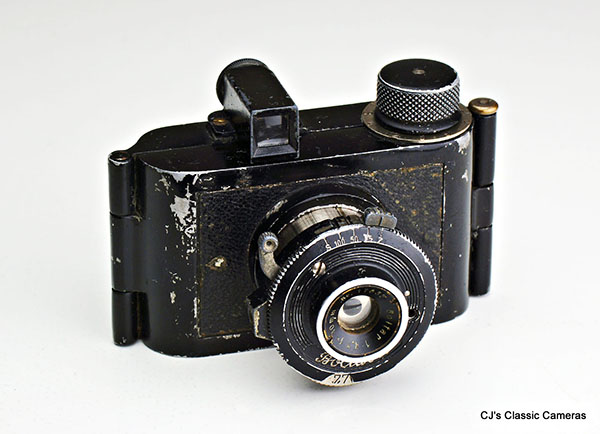
Somewhat grubby example of the black version of the Boltavit I with Boltar 40mm f/7.7 lens.
Chrome 'De Luxe' version of the Boltavit I. Unlike later models which had a depth of field table at the back, the early Boltavits had their name embossed in leather.
The very first Boltavit model had large hinges on both sides of the camera. The later (1937) Boltavit II had smaller hinges as well as a depth of field table at the back of the camera. Both were available in standard black enamel or as a luxury chrome-plated version. The Boltavit I is most commonly found with a Boltar 40mm f/7.7 lens in a 3-speed self-cocking shutter, or with a faster Corygon-Anastigmat f/4.5 lens. The Boltavit II was available with the Corygon Anastigmat or with a faster Meyer Trioplan lens. The least common ones are those with Prontor II shutters. During production of the Boltavit II the company renamed their cameras to Photavit, so the Photavit I is the same as the Boltavit II except for the markings on the shutter and camera back.
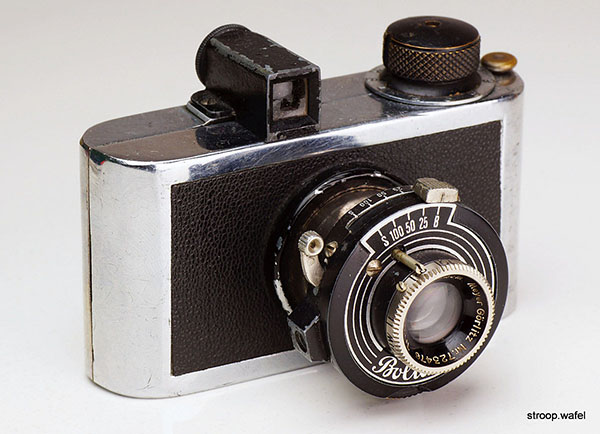
Chrome-plated version of the Boltavit II with Meyer Trioplan 40mm f/4.5 lens. The aperture ring has different size holes for each aperture setting instead of an iris.
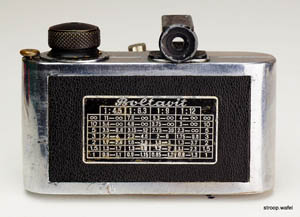
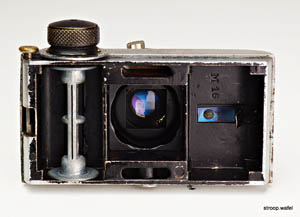
Rear view of the same Boltavit II with back panel in place (left) and removed (right). The camera featured a depth of focus scale on the back. On the inside the code M16 is stamped, perhaps this is a serial number, as it is also stamped on the back plate. The black version below has a different numbers, so do a few I found on the internet.
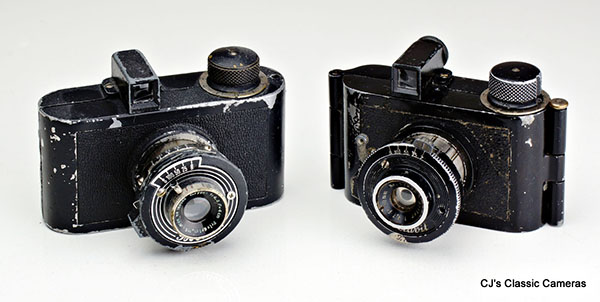
Comparison of standard black versions of the Boltavit I (right) and II (left). Note the Boltavit II looks a little larger due to the loss of the external hinges that are present on the Boltavit I.
By the way, this Boltavit II (with Friedrich Corygon 40mm f/4.5 lens) was a spares and repairs item: the shutter does not work, the timing and release levers are missing, and so are the pin securing the cameras back plate and the rear cell of the viewfinder!
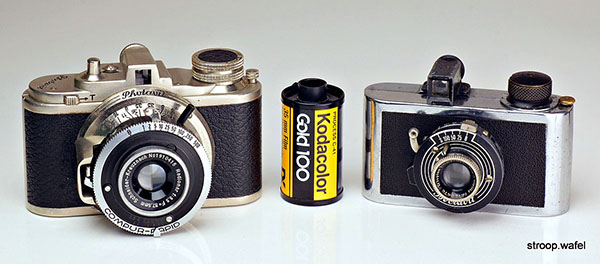
A Boltavit II and Photavit IV together with a roll of 135 film (which can be used to load the cassettes), just to show how small the Boltavit really is.
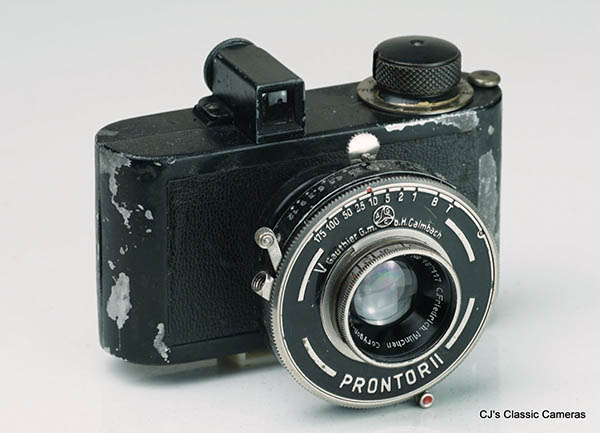
The Boltavit II was also available with more capable shutters, such as this example with Friedrich Corygon lens in Prontor II shutter. The shutter diameter was actually larger than the height of the camera body.
Photavit II
The 1938 Photavit II had a completely redesigned body with body-mounted shutter release and double-exposure prevention. The lens was still collapsible and was front-cell focussing, in contrast to most later Photavits. The camera used a cassette system not unlike the Karat cassettes but it had a spool inside the cassettes, so essentially it was a roll film without the need for paper backing. It could be used with standard 135 film - the perforations had no use but the 25x25 mm film frame would fit in-between them. As one would turn the wind spool the same amount for each picture (determined by the camera's wind lock mechanism), the spacing between consecutive frames increased with each picture taken (see below).
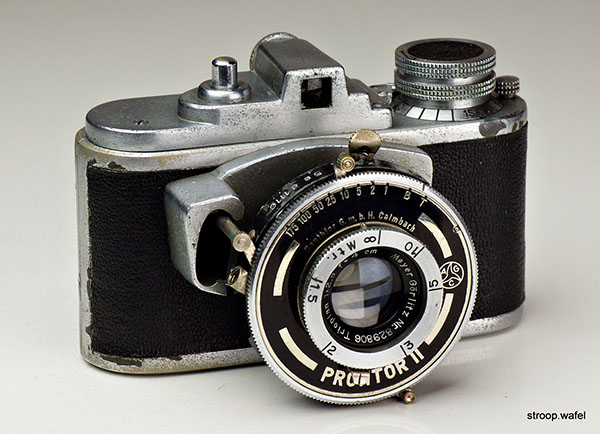
A little scruffy-looking Photavit II with collapsible Meyer Trioplan 40mm f/2.9 lens in Prontor II shutter. As the lens is coated this is probably a post-WWII model.
Photavit III
The 1946-7 Photavit III differed from the Photavit II mainly by having helical focus with a focus indicator and depth of field scale mounted on the body. Moving the focus lever up and down would extend and retract the lens tube to achieve proper focus. Also new was that 'Photavit' was engraved on the top plate. The lens was no longer collapsible. The camera still had the same wind mechanism as the Photavit II meaning that the space between frames increased by about 1 mm with each picture taken.
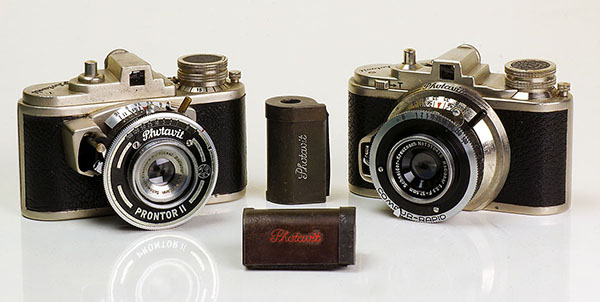
Photavit III on the left and Photavit IV on the right, displayed with a couple of Photavit cassettes. Both cameras have Schneider Radionar lenses, the silver one on the Photavit III looks a little suspicious and probably the black lacquer has been polished away. Note the difference between the lens mounts.
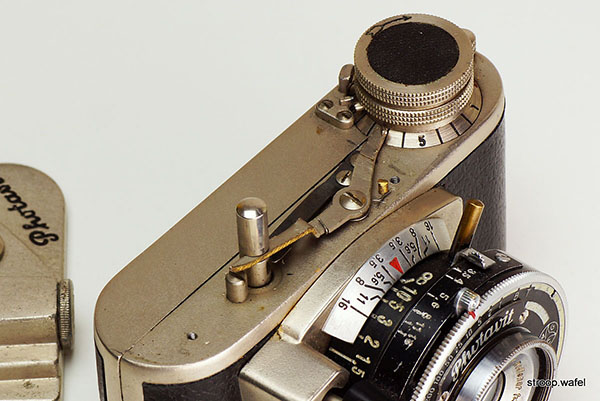
Wind mechanism of Photavit III with top plate removed. The double exposure prevention was de-activated by a small notch on the wind knob, which is just engaged in this picture. The wind lock was a simple physical stop, the wind knob had to be lifted to turn it further.
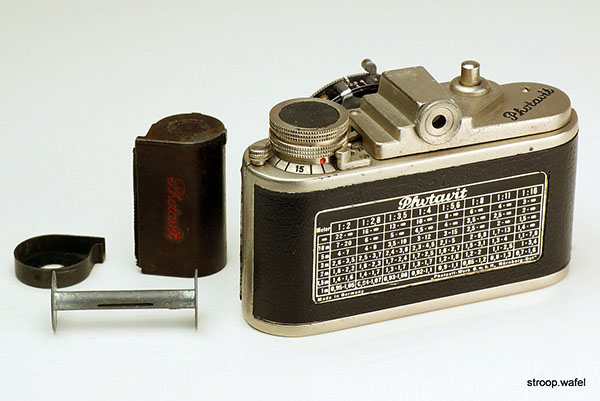
Rear view of the Photavit III showing its depth of field table. Also shown is a disassembled Photavit cassette. The film groove is lined with velvet to avoid the film being scratched.
Photavit IV
The 1947-8 Photavit IV had several changes compared to the Photavit III. It received a T button which could be used to keep the shutter open for any length of time. It no longer had an external wind lock mechanism, instead it had a sprocket wheel and therefore the space between frames was constant. It had a separate frame counter behind the shutter release button instead of beneath the wind knob as in previous models. It also had a small lever to reset the counter to zero. The lens base was enlarged and had Photavit engraved on it. In addition, a serial number was stamped on the base of the camera, which was lacking on the Photavit II and III.
Later in the production, from around serial# 8,500, a cable release socket was added, probably because operating the T button would often result in camera shake. Even later models had a rewind button which no longer had a ridge through the middle. Most Photavit IV had a Compur-Rapid shutter, although one can find Compur, Prontor-s and even Prontor II shutters as well. The very last batches were equipped with a Synchro-Compur. The highest serial number I have seen is 28,458, the lowest was probably 1,000, but there was considerable overlap with the Photavit 5 (from 15,000 up to 27,000) so at least around 20,000 Photavit IV were probably made.
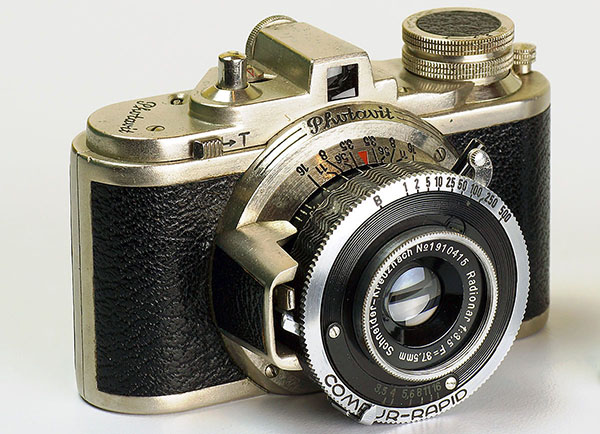
Early version of the Photavit IV without cable release socket. It sports helical focussing, a Compur-Rapid shutter and a Schneider Radionar 37.5mm f/3.5 lens, not a bad package for such a small camera!
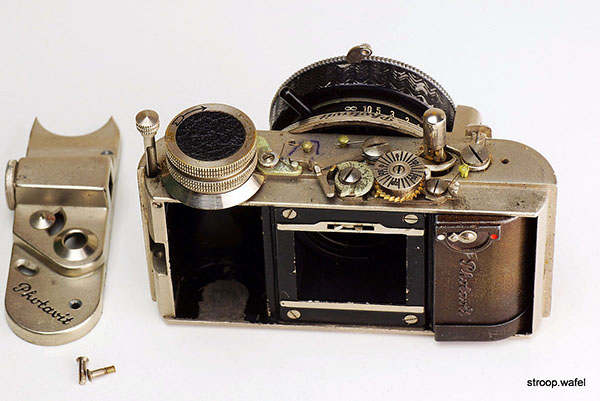
Photavit IV with top removed to expose the wind mechanism, double exposure prevention and frame counter. Note the sprocket wheel driving the wind lock mechanism, missing on the earlier Photavit models.
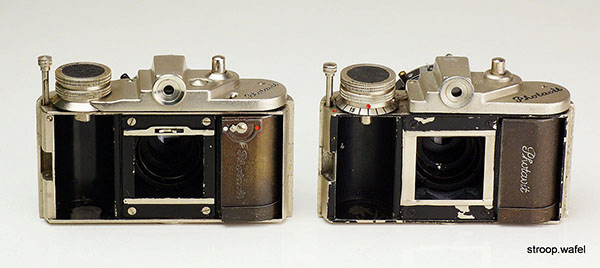
Photavit IV (left) and III (right) with backs removed and Photavit supply cassettes in place. Note the sprocket wheel of the Photavit IV, missing on the Photavit III. The film gate is 25x25mm on both cameras.
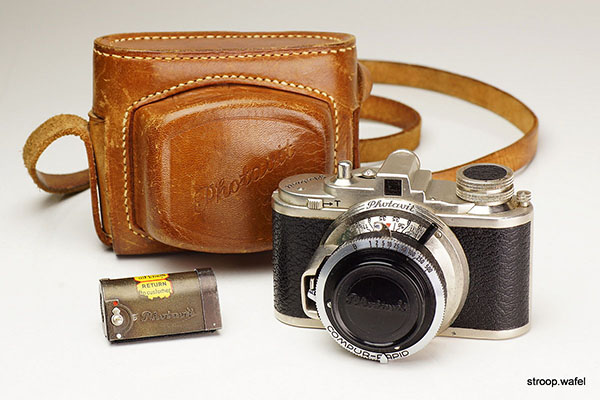
Photavit IV with its original lens cap, leather case and Photavit cassette. The cassette has a little dial to indicate whether it is an uptake or supply cassette. It also has a sticker saying 'return to customer.' You certainly did not want to lose those!
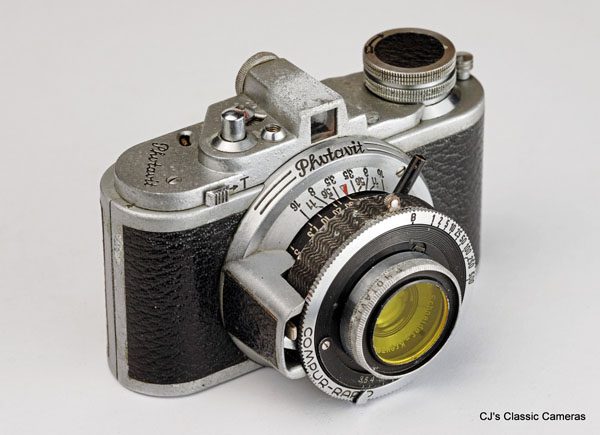
Late Photavit IV which had a cable release socket fitted (next to the shutter button).
Photavit 'Bolta' (828 film variant)
A rather rare Photavit variant recently came to my attention. It looks very much like a Photavit IV from the outside, but the name engraved in the top plate and on the shutter base is 'Bolta'. My initial thought was that perhaps this was a name variant, as so many makers did, selling a camera under a different name in a different country. However, something else was unusual, the camera was actually designed to be used with 828 film, a type of roll film. Now, there was in fact a Photavit variant made to be used with 828 film, the Photavit 828. It can be seen further down this page. But that model carried the name Photavit and had clearly marked on the bottom 'Film 828'.
Bolta also made their own Bolta rollfilm which was used in the early Boltavits and was similar to 828 film but without any numbering on the backing paper and a different spool diameter, so I did briefly consider that this Photavit Bolta was meant to be used with this film, but it is not, as only 828 film spools fit. So my best guess is that this was an early variant of the Photavit 828, given a different name to differentiate it from the regular Photavit. I have also seen a slightly different example where the original name Photavit on the top plate has been covered with a new name plate saying Bolta. Perhaps these were special requests, perhaps prototypes to try out the market, who knows. But eventually they seemed to have been replaced by the Photavit 828 below, which was made in considerable numbers, unlike the 'Bolta' of which only very few appear to exist.

Photavit IV variant using 828 film called 'Bolta'. Many thanks to Mike Eckman who found this camera and got in touch asking what model it was, and agreed to a camera exchange after I told him this was a model I had not seen yet.
Top, bottom and inside of the 'Bolta' (click photos to enlarge). The inside is identical to the Photavit 828 below. In fact, the whole camera is identical except the name 'Bolta' and the lack of the Film 828 engraving on the bottom. The serial number is within the Photavit IV range.
Photavit 828
A rare variant of the Photavit IV was the Photavit 828. It was based on the last production model of the Photavit IV but used 828 film, which is a non-perforated roll film version of 135 film with paper backing. The camera had no red spy window at the back, as instead of a film sprocket wheel the camera had a grooved wheel which ensured even spacing of film frames, as well as a small wheel in the pressure plate to grip the film tight. Also, it had little hooks that needed to be closed to hold the wind spools in place. A maximum of 14 shots could be taken, with the film frame being the same 25x25 mm as regular 35mm film Photavits. The camera had Film 828 engraved on the base of the camera. This return to Photavit's roll film origins is a little ironic, as its own Bolta film format was similar to 828 film but abandoned with the introduction of the Photavit II. The Photavit 828 had a different range of serial numbers than other Photavit models, most likely starting at 50,000. The highest number I have seen is 52,164, so over 2000 were made. Note an early variant of this model called 'Bolta' existed, see above.
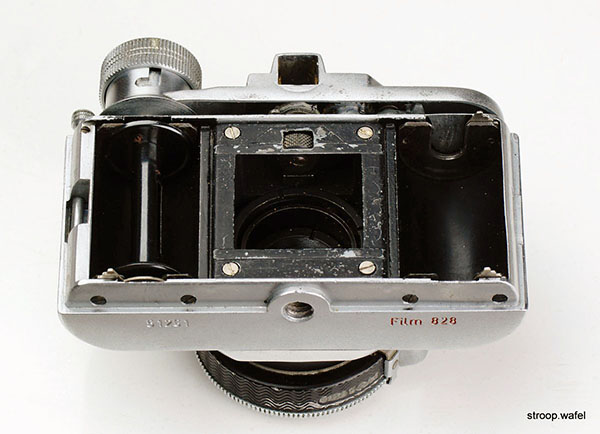
Rear view of Photavit 828 with the back removed showing the roller wheel that replaced the sprocket wheel for this rollfilm version of the Photavit IV. Careful observers will have noticed that the eyepiece of the viewfinder is missing, one of the more common problems with Photavits, as they tend to get loose over time. Worth checking if you own one.
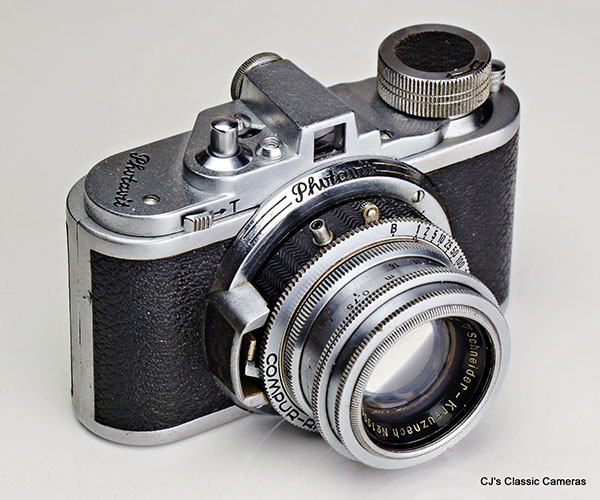
A rather rare specimen, not just a Photavit 828, but with a Xenon lens no less! This is the only Photavit camera with Xenon lens I have ever seen, which made me wonder if this was original. The good news is that the shutter as well as the lens serial# fall within the range of other Photavit 828 and that the lens is properly collimated. Perhaps this was a special order? An additional interesting feature is that the complete lens is in front of the shutter and can be unscrewed (22.5mm, same thread as the Altix III), so is in fact interchangeable. The aperture adjustment is on the lens and not built into the shutter, as on other Photavits.
Photavit V
The 1951 Photavit V had a front-cell focusing lens, a Roeschlein Kreuznach Luxar 38mm f/2.9 in Prontor-S, SV or Vario shutter. This was a clear deviation from earlier Photavit versions with helical focus, Compur shutters and Schneider-Kreuznach lenses. That way it could be sold for a more competitive price. Roeschlein was a small lens maker compared to its big brother Schneider from the same city, but did produce some interesting lenses mostly for Braun, including the highly-reputed f/2 Luxon.
The Photavit V camera body was identical to the last version of the Photavit IV. Considerable overlap exists two models' serial numbers, which makes sense as the cameras were sold side by side, the Photavit V being the cheaper variant. The highest serial number I have seen is 26,970, so probably around 4-5,000 were made. This was the last Photavit subminiature model produced - the later Photavit 36 (see below) was a regular 35mm camera.
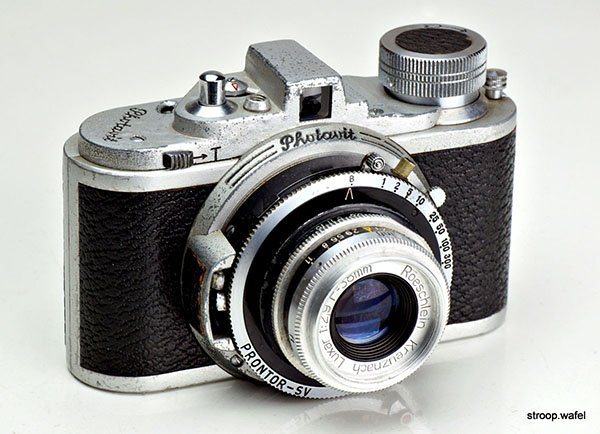
A Photavit V with Roeschlein Luxar f/2.9 lens in Prontor-SV shutter. Front-cell focusing lenses are said to be less good at close focusing than unit-focusing lenses, which may explain the slightly longer closest focus of this lens (1m) compared to earlier Photavit models (0.75 m).
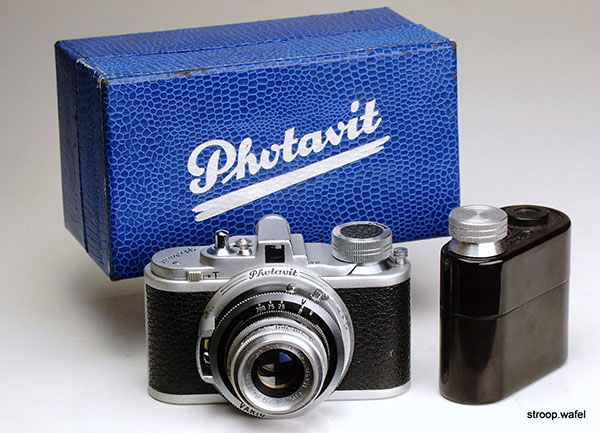
A Photavit V (variant with Vario shutter) shown with its original box and a film loading tool which allowed loading Photavit cassettes with 35mm film without much hassle. Camera and film loading tool fitted together in the box.
Photavit film frames
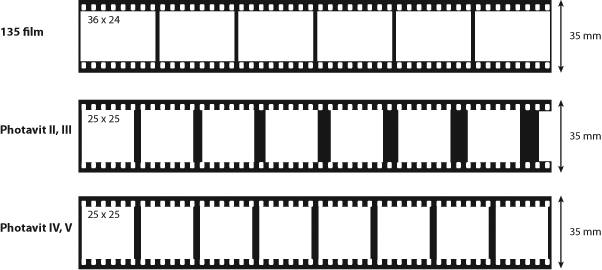
Frame space and size for different cameras. (top) standard 135 film camera (middle) Photavit II and III with increasingly large frame spacing (bottom) Photavit IV and V with constant frame spacing. The Photavit II and III would fit less photographs on the same amount of film. Finetta cameras had a similar issue.
Photavit 36
The 1956 Photavit 36 was a completely new camera design not unlike the Braun Super III. With that model it also had the interchangeable lens mount in common: the Prontor SVS mount, also used by the King Regula cameras (see under Braun Super III for detail comparison). This was Photavit's first rangefinder camera and came in two versions: with or without light meter. 35mm wide angle and 135mm telelenses were available in addition to the 45mm and 50mm standard lenses; perhaps there were more as indicated by advertisements from that time.
The Photavit 36 is rather rare. They have serial numbers on the back and appear to continue from the Photavit range or possibly started at 30,000. I have seen 30,147 as lowest and 34,356 as highest, so it appears at least 4000 Photavit 36 were made.
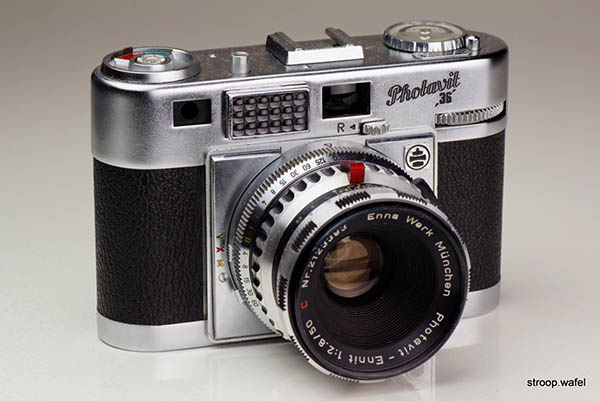
Photavit 36 with uncoupled light meter and Enna Photavit-Ennit 50mm f/2.8 interchangeable lens. Note the akward position of the rewind button: just below the viewfinder window.
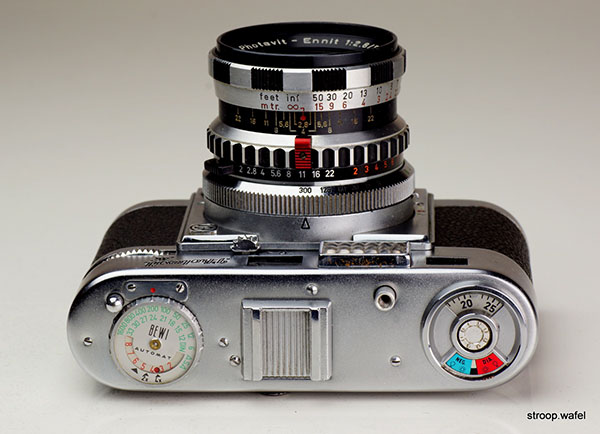
Top view of the Photavit 36 with uncoupled light meter. I have not quite worked if and how the Bewi Automat light meter functions, it wizzes around when I push the button next to it but it always ends up at the same value.
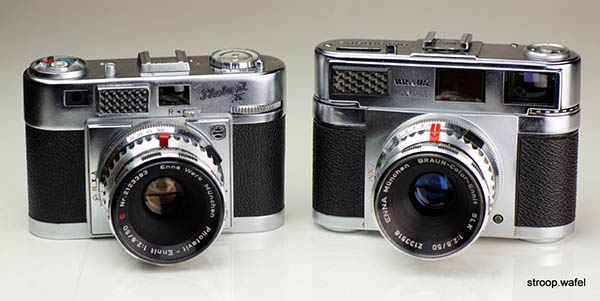
Photavit 36 compared to the Braun Super III with which it shares a more than superficial likeness. The Photavit is let down by its rather poor viewfinder.
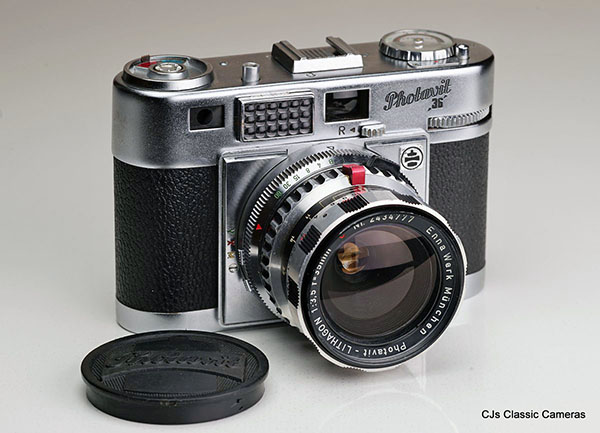
Several interchangeable lenses were available for the Photavit 36, although one doesn't come across them very often. Here is a Photavit 36L with Enna Werk Photavit-Lithagon 35mm f/3.5 lens, which is identical to the Braun and Regula versions of the lens, except for differences in the mount, as discussed here
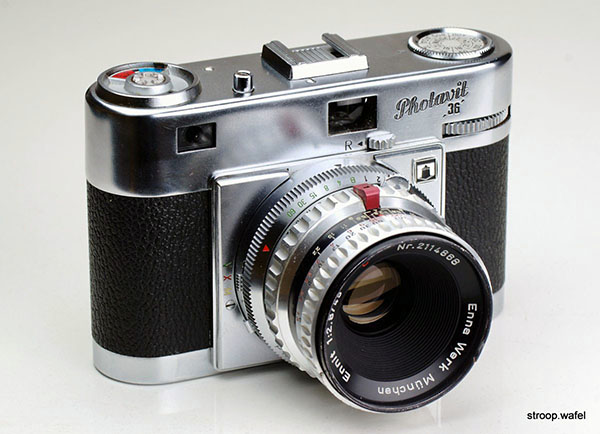
Variant of the Photavit 36 without light meter. The lens was similar but not identical to the one on the other example above: this one lacked the name 'Photavit' on the lens ring and was at 45mm also slightly wider.
Photina II TLR
The 1952 Photina was a TLR camera, perhaps a somewhat unlikely venture for a company known for its sub-miniature cameras. There were several versions, the first was a pseudo-TLR with non-coupled viewing and taking lens, the Photina II had a faster shutter and lens, the Photina Reflex was a true TLR camera with Steinheil Cassar or ISCO Isconar 75mm f/3.5 viewing and taking lenses in a Prontor-SVS shutter. This range was reasonably successful and were sold under license in the USA by Sears as Tower Reflex II, III and 30, respectively.
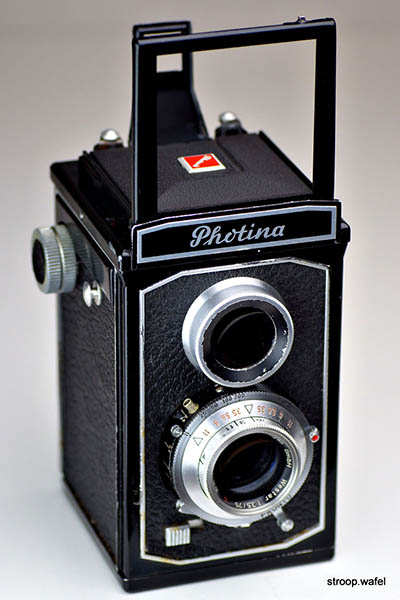
Photavit Photina II, a pseudo TLR with Isco Westar 75mm f/3.5. It was essentially just a box camera and in fact the built-in viewfinder, as shown in the photo, was probably better for framing than the mirrored image of the frosted glass viewfinder.
| 
